
Kings were once commonplace at Forteviot. At the height of its importance in the ninth century, it was the residence of the most powerful northern kings of their age: the Pictish Constantine son of Fergus and Cinaed mac Alpin. It has been a long time since there was a royal assembly held at Forteviot, possibly not since Edward Balliol camped here before the Battle of Dupplin Moor in 1332. For a non-military popular assembly one may have look further back to 1165 when William I the Lion signed the last royal charter at Forteviot.
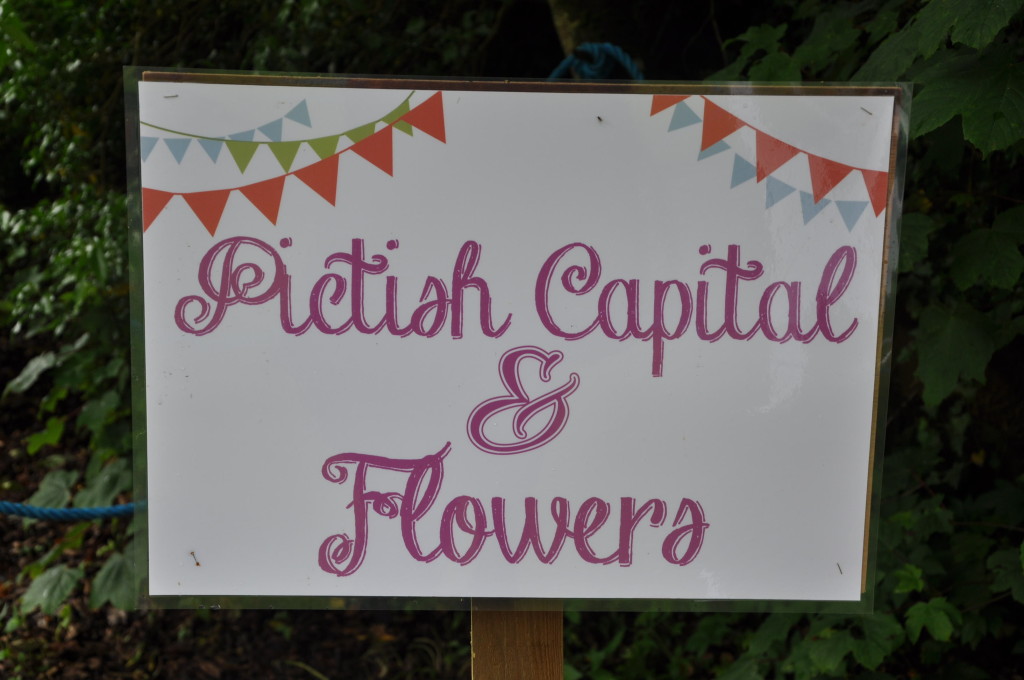
This summer a future king returned to Forteviot, if only for a May day. On Thursday the 29th HRH Prince William and Duchess of Cambridge (known in Scotland as the Earl and Countess of Strathearn) visited a fête specially convened in their honour. This was the first opportunity the rural Strathearn community has had to welcome the Earl and Countess since these titles were bestowed on them their marriage. It has also been a long time since an Earl was seen in Strathearn: the Earldom ceased to exist in 1437, but like the kingship it has deep roots extending back to the semi-autonomous Pictish lordships ruled by Mormaers. This early medieval history is one of the reasons why my colleagues and I were attracted to Forteviot leading to the launch of SERF (Strathearn Environs and Royal Forteviot) project:
http://www.gla.ac.uk/schools/humanities/research/archaeologyresearch/projects/serf/.
When the SERF team were invited to participate in a “village fête” we were delighted at the opportunity to present our archaeological findings to the welcoming and supportive local community in an informal settling. It was only later that we learned of the special guests and the importance of the occasion to the community. Slowly we began to appreciate the honour of having been included.

The informal day of one-to-one conversations that we had anticipated was replaced by a precisely choreographed royal event. Although the specific arrangements of introductions, performances and stalls – featuring the work of farmers, game-keepers, foresters, artisans and artists – were locally determined, these were placed within a framework constructed by the royal household, partially for security reasons and partially for social protocol.
Although on a day-to-day level, Forteviot is typical of an east midlands Scottish village, its appearance is far from typical, because in the 1920s it was rebuilt as a model village in the Arts and Crafts style. The design was intended to celebrate Forteviot’s royal past, a point emphasised by a monumental inscription recalling Cinaed mac Alpin’s death in the centre of the scheme. The model dwellings wrap around a square central green, which for the occasion was filled with market stalls run by local artisans and food producers. The hall on the opposite side of the road from the square was transformed into an art gallery and colossal pieces of gleaming farming machinery were squeezed behind the hall as a reminder of Strathearn’s main business: barley and tatties.
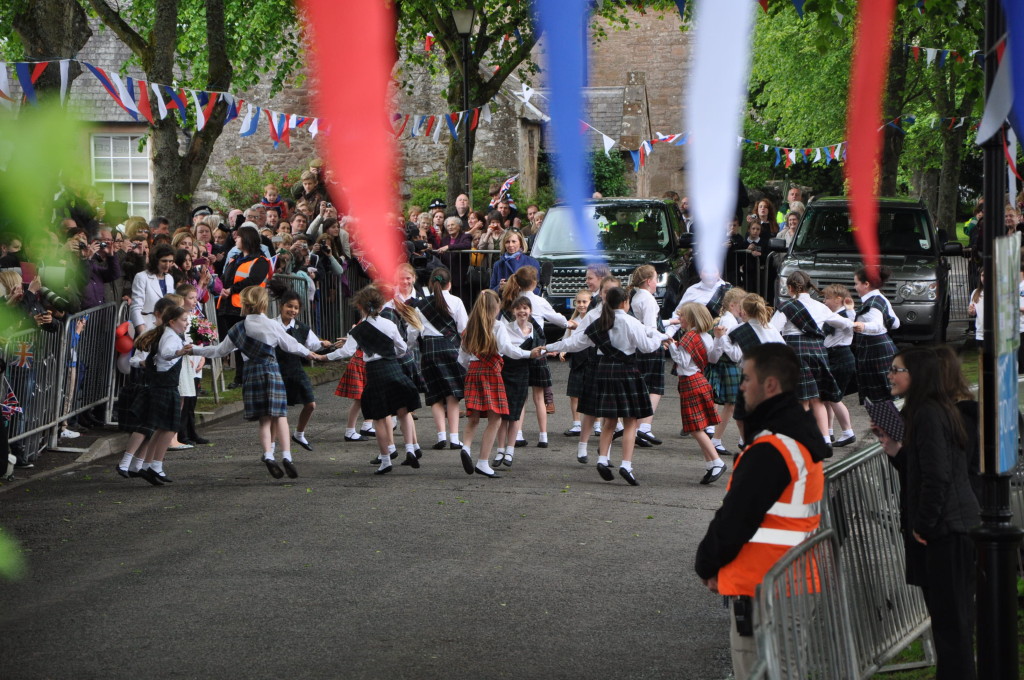
Several hundred local people packed into the village where they were marshalled by stewards and jovial policemen. There was little advanced publicity for the event. Most of the people present had learned of the royal visit by word of mouth, so in that respect it was a genuine community event, a gathering of friends and neighbours. The village had been groomed, gardens tweaked, paint refreshed, bunting hung. The crowd too had made an effort: many were in their Sunday best, smart tweeds and kilts were prominent. The local brass band and a ceilidh band contributed to the festive atmosphere, heroically playing almost continuously for about three hours.
The weather played its part, improving and brightening through the day rendering all the emergency umbrellas and awnings redundant. Small Union Jacks and Saltires were passed out: to judge from the choice of flags this is ‘Better together’ territory, although there were a good few Saltires too. The impending arrival of the royal pair was signalled by increasingly frequent security sweeps and the use of crowd barriers to control movement. The gathering was large enough to line both sides of the road two or three deep, which created a sense of occasion without being claustrophobic. When the royal party arrived in three sleek Range Rovers, there was no disappointment.

Lord Forteviot and his household welcomed the royal party, hands were shaken, curtseys were made and then the royal party moved amongst the people, conducting a circuit of the stalls in the square. The crowd surged around the couple like a shoal of fish accompanied by frantic press photographers scurrying around with long lenses and step-ladders. Everyone at the event would have had a very close encounter with one or another of the royal couple, many would have exchanged words. Once the circuit of the square was complete the Royal couple split up with Kate (and all the photographers) going to view the art on display in the village hall and the Prince going to the church where we and the church elders had been stationed. Having viewed all of the displays, the Royal party reassembled in the centre of village to watch a final Scottish country dance performed by young girls sporting tartan sashes. Once final photographs had been taken the party returned to the vehicles and left under the escort of the local pony club.
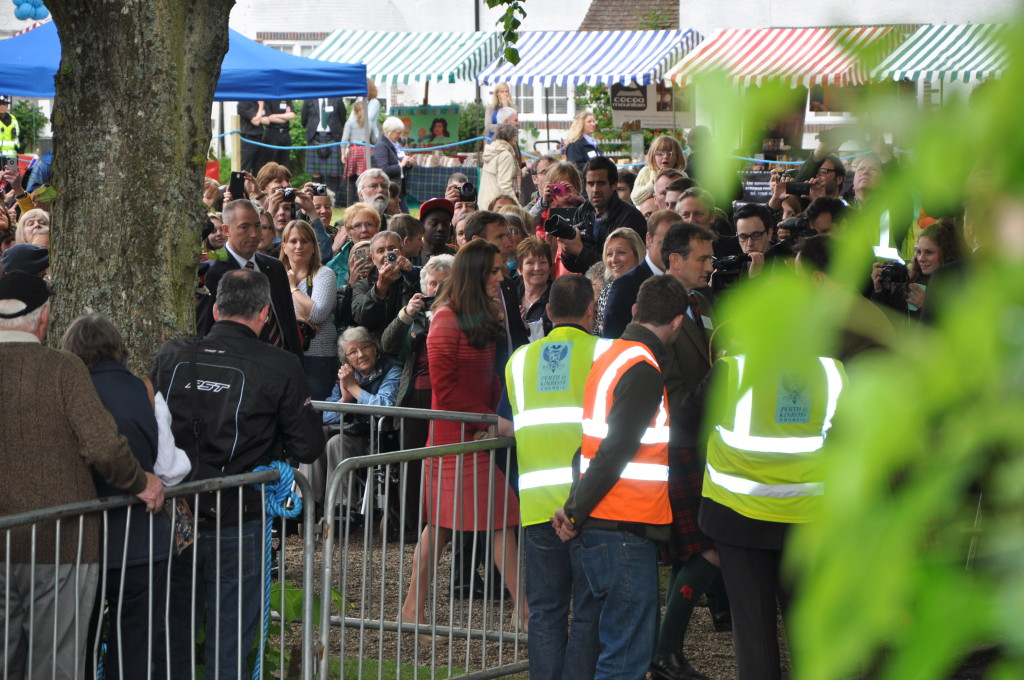
The archaeologists’ role in the day’s proceedings was small but challenging: it was our task to convey Forteviot’s hidden historical importance, reveal its deep antiquity and recall its early medieval royal dignity. Seven years of fieldwork needed to be compressed into a five-minute conversation; our slot was comparable to the duration of the Scottish country dancing display by the local girls’ school. It will probably take you longer to read this reflection than we spent with HRH. On the day we focused on the two exceptional past social institutions which gave rise to Forteviot’s importance: the early prehistoric ritual complex and the Pictish royal palace. We supported our argument with a small display of photographs, drawings and artefacts within the church of St Andrew.

Of the two the Pictish age is easier to convey than the Neolithic. For a start, Forteviot remains a small village, which has resisted the widespread suburbanisation of the countryside, although the residents no longer labour in the fields and mostly work in cities. In its tiny scale Forteviot resembles a large estate centre rather than a town. The oldest building, the church, dates to the 17th century, but our excavations showed that it was built directly on the walls of the medieval church, itself probably on the site of an earlier Pictish church. All that remains of this substantial stone church is a unique monolithic arch dating to the 8th or 9th century, now in the National Museum of Scotland, which apparently depicts its royal founders. Further pieces of high quality sculpture from the parish attest to a royal level of patronage. Most spectacular of these is the Dupplin Cross, dedicated in an inscription to the Pictish King Constantine son of Fergus (d. 820), which formerly marked the northern approach to Forteviot and is now sheltered in St Serf’s church in nearby Dunning . Fragments of three other of monumental stone crosses remain in the church at Forteviot and provide tangible evidence of its Pictish greatness.
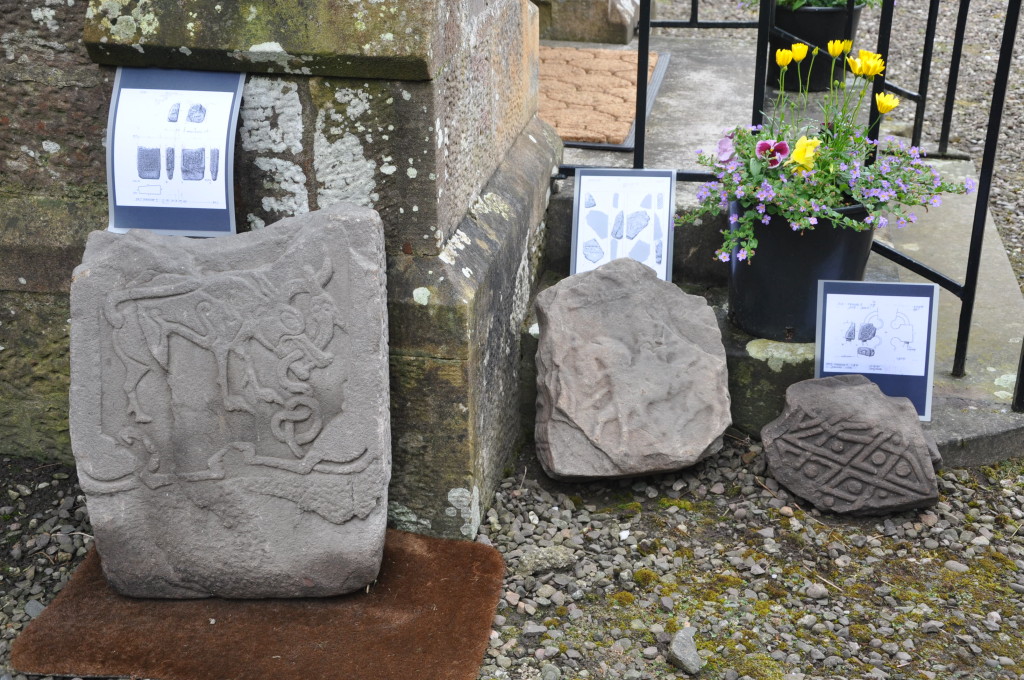
Conjuring up the ancient Neolithic and Bronze Age is more difficult as the monuments are more or less invisible. Largely built of earth and timber, these henges and barrows have been ploughed flat by generations of industrious farmers and were only rediscovered in the 1970s through aerial archaeology. This extensive complex of ritual monuments has an appropriately ethereal and other-worldly quality: they appear as cropmarks only fleetingly. The earliest and most remarkable was a great enclosure defined by a massive circle of oak posts over 200m across: the vast scale and rarity of the site has invited comparison with its contemporary southern counterpart, Stonehenge. Despite the decay of the Neolithic enclosure the area retained its sanctity from generation to generation as is evidenced by burials stretching over millennia.

Our most spectacular find is one of these graves: an Early Bronze Age burial in a megalithic stone cist equipped with a gold-hilted bronze dagger. Despite being unable to present our star find, the dagger (as it is very fragile and was then on display in the Hunterian Museum Scottish Gold exhibition) this artefact caught the royal imagination. The exceptional conditions in the cist preserved the organic materials in the hilt revealing that the pommel was made of a sperm-whale tooth: we discussed how unusual this was and how a whale might be acquired in the Bronze Age. More representative of our prehistoric relics were the delicately decorated Beaker pottery sherds and finely crafted stone tools we displayed and which we hope conveyed the fragile beauty of the archaeological evidence.

There was no time to consider the extraordinary micro-environmental conditions in the cist grave which allowed for the preservation of a bouquet of meadowsweet, at over 4000 years old, the earliest surviving floral tribute in Britain. Indeed there was scarcely time to mention our key discoveries to the Prince: evidence of a connection between these two eras of greatness. Our excavations have provided unambiguous evidence that the Picts, who established the royal centre at Forteviot, were deeply interested in the already ancient monuments. They dug into the henges long before we did, they built massive fires on the site of the pagan burial mounds and buried their dead alongside their prehistoric ancestors. It is hard to escape the conclusion that Forteviot was specifically chosen to be a Pictish royal centre because of its ancient significance and we must marvel at how collective memory preserved this sense of importance over the millennia. We passed on one of the last remaining copies of our interim report, but before the prince returned to the heart of the fête on the village square he asked about our students. We were pleased to be able to tell him that Forteviot was the central training ground for Glasgow students and attracted others from around the world. Had there been more time we would have spelled our belief in the advantages of teaching within an active research project.
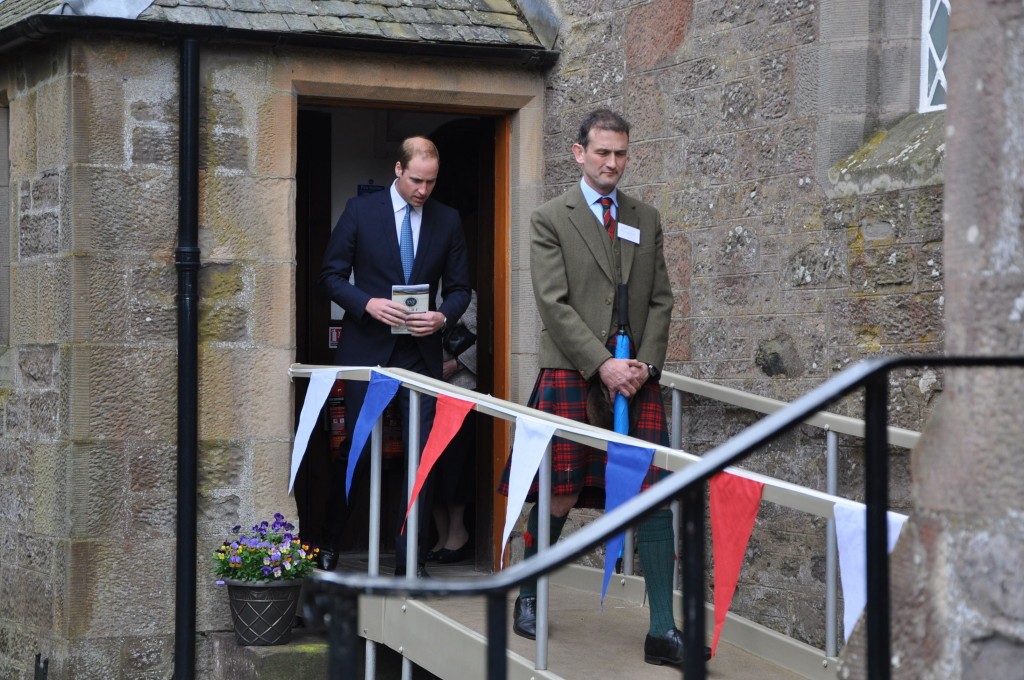
Quite apart from the novelty of presenting our discoveries to a royal audience, the fête has been a remarkable stimulus to participants, such as ourselves, to think about the connections between Forteviot as a place of assembly in the past and now. Compared to the medieval royal assemblies, the Forteviot Fête was a mere gesture of loyalty duly acknowledged by the monarchy. No important business was transacted and it lasted only a few hours, and no real hospitality was partaken of other than a very warm welcome. By contrast, we should imagine that when Cinaed mac Alpin came to Forteviot he enjoyed local hospitality at length, possibly to celebrate a special feast day and to give thanks in this holy place for his prodigious military successes. It would have been an occasion when business was conducted, disputes resolved and bonds of loyalty reinforced. We cannot know as much about early prehistoric assemblies, but they must have been vast, attracting people from all over northern Britain to judge from the scale of the monuments. Quite possibly they were much larger than the medieval gatherings. In both cases the agricultural wealth would have been central to the celebrations and the feasting would have been accompanied by devotional acts intended to secure future prosperity and fertility. So, although this year’s royal assembly was compressed and abbreviated compared to earlier ones, there are similarities with the assemblies of the distant past. Possibly the chief of which is that Forteviot has always served as a temporary place of gathering to celebrate particular events; it was never a permanent hub or industrial hive. It always remained god’s country, celebrated for its productivity.

Of the many things that we wished we had squeezed into our few minutes was an expression of appreciation for those have supported our work. These include virtually everyone from Strathearn who we have turned to for help over the past eight years; it includes many colleagues who were not present at the fête; and the hundreds of students and volunteer diggers who provided the labour. It includes the management of the University of Glasgow, which has learned to tolerate the financial knife edge we are walking. Above all we must acknowledge the support and guidance we have received from the staff of our main sponsor, Historic Scotland, which, remarkably for a government body, has proved flexible and encouraging over an unprecedentedly long period.
By Professor Stephen T Driscoll 17-06-2014

